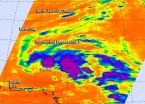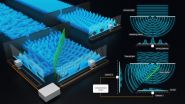(Press-News.org) SAN DIEGO – Nearly all parents unknowingly put their newborn infants at risk as soon as they drive away from the hospital due to mistakes made with car safety seats, according to research to be presented Monday, Oct. 13 at the American Academy of Pediatrics (AAP) National Conference & Exhibition in San Diego.
A study of 267 families at Oregon Health and Science University Hospital showed that 93 percent made at least one critical error in positioning their infant in a car safety seat or when installing the safety seat in the vehicle. The National Highway Traffic Safety Administration has defined critical errors as those that put infants at increased risk for injury in a crash.
"Car safety seats can be difficult to use correctly for many families, and we need to provide the resources and services they need to help ensure the safest possible travel for newborns and all children," said Benjamin Hoffman, MD, FAAP, lead author of the study "Unsafe from the Start: Critical Misuse of Car Safety Seats for Newborns at Initial Hospital Discharge."
Dr. Hoffman and his colleagues enrolled randomly selected mother-infant pairs in the hospital's mother-baby unit from November 2013 to May 2014. Infants born at less than 37 weeks' gestation and those who stayed in the neonatal intensive care unit for more than four hours were excluded from the study.
A certified child passenger safety technician observed new mothers or a designee position the newborn in the car safety seat and install the seat in the vehicle in which they would be leaving the hospital. The technician recorded all misuses based on car safety seat and vehicle manufacturer recommendations. Prior to departure, technicians helped caregivers correct all mistakes.
The most common errors in positioning the infant included harness being too loose (69 percent), retainer clip too low (34 percent), use of after-market product not approved with seat (20 percent), harness too high (18 percent) and caregiver not knowing how to adjust the harness (15 percent).
The most common installation errors were car safety seat installed too loosely (43 percent), angle of car safety seat incorrect (36 percent), safety belt used but not locked (23 percent) and incorrect spacing between car safety seat and vehicle front seat (17 percent).
Families with increased risk for one or more critical errors tended to be of lower socioeconomic status, had less education, were non-white, did not speak English, and were unmarried or without a partner. Families who had worked with a certified car seat technician prior to their child's birth were 13 times more likely to position their baby correctly and install the car seat correctly in their vehicle.
"We need to move beyond the idea that we cannot afford to develop and support child passenger safety programs," said Dr. Hoffman, professor of pediatrics and medical director of the Tom Sargent Children's Safety Center at Doernbecher Children's Hospital, Portland, Ore. "Car crashes kill more kids that any other cause; we can't afford not to."
INFORMATION:
Dr. Hoffman and his colleagues will discuss the study at 10:15 a.m. PDT Oct. 13 in Marriott Hall 6 at the San Diego Marriott Marquis.
The American Academy of Pediatrics is an organization of 62,000 primary care pediatricians, pediatric medical subspecialists and pediatric surgical specialists dedicated to the health, safety and well-being of infants, children, adolescents and young adults. For more information, visit http://www.aap.org.
SAN DIEGO – Youth baseball has morphed into a year-round sport, with some athletes playing on multiple teams in the same season. One result: an increasing number of pitchers sidelined with overuse injuries or needing surgery.
Guidelines on how many pitches young athletes should throw have been developed to stem the tide of injuries, but many coaches are not following the recommendations consistently, according to a study to be presented at the American Academy of Pediatrics (AAP) National Conference & Exhibition in San Diego.
"Our results show that youth baseball ...
SAN DIEGO – When a child goes to the emergency room with a possible broken bone, a splint often is used to stabilize the injured limb and reduce pain until the patient is seen by an orthopedic specialist. However, many splints are put on incorrectly, leading to swelling, skin irritation and poor healing, according to a study to be presented Saturday, Oct. 11 at the American Academy of Pediatrics (AAP) National Conference & Exhibition in San Diego.
"Splints are effective for immobilization of fractured extremities in children and adolescents when placed appropriately," ...
SAN DIEGO – Mothers who decide to breastfeed their children beyond 1 year of age consider their child's physical and social development to be most important, while the advice of health care professionals, family and friends are least important, according to a study to be presented Monday, Oct. 13 at the American Academy of Pediatrics (AAP) National Conference & Exhibition in San Diego.
To find out why some moms choose to continue nursing after a child's first birthday, researchers surveyed more than 50,000 U.S. women ages 18-50.
"The three most important reasons ...
SAN DIEGO – With football season in full swing, there's no shortage of talk about young players — from high school down to the pee wee levels — suffering from concussions. Yet many parents may lack knowledge about this mild traumatic brain injury, according to two studies to be presented Friday, Oct. 10 at a pre-conference symposium on pediatric sports medicine at the American Academy of Pediatrics (AAP) National Conference & Exhibition in San Diego.
Nearly 175,000 children are treated in U.S. emergency rooms each year for concussions due to sports-related ...
SAN DIEGO – Telling youths who are juggling multiple electronic devices to "focus on the task at hand" may not always be good advice, according to research to be presented by two high school students on Saturday, Oct. 11 at the American Academy of Pediatrics (AAP) National Conference & Exhibition.
Sarayu Caulfield and Alexandra Ulmer, seniors at Oregon Episcopal School in Portland, Ore., will present their study "Capacity Limits of Working Memory: The Impact of Media Multitasking on Cognitive Control in the Adolescent Mind" from 1-1:30 p.m. in Marina Ballroom Salon ...
SAN DIEGO – October 10, 2014. More than 90 percent of potential pediatric fractures are splinted improperly in emergency rooms and urgent care centers, which can lead to swelling and skin injuries, according to a study by researchers at the University of Maryland School of Medicine. The findings are being presented at the American Academy of Pediatrics (AAP) National Conference & Exhibition in San Diego.
The study looked at 275 cases involving children and teenagers up to the age of 18 who were initially treated in community hospital emergency rooms and urgent care ...
Ann Arbor, Mich. — A web-based system that allows preschools and child care centers to report illnesses to local public health departments could improve the detection of disease outbreaks and allow resources to be mobilized more quickly, according to University of Michigan research to be presented Saturday, Oct. 11 at the American Academy of Pediatrics (AAP) National Conference & Exhibition in San Diego.
Researchers who designed the biosurveillance system will describe how it can be used to track illness trends and improve public health response to outbreaks during ...
The seventh depression of the Atlantic Ocean Hurricane Season was born on Oct. 10, but it's subtropical. NASA's Aqua satellite looked at the developing depression in infrared light and saw strong thunderstorms within.
The Atmospheric Infrared Sounder or AIRS instrument aboard NASA's Aqua satellite captured data on developing Subtropical Depression 7 on Oct. 10 at 05:41 UTC (1:41 a.m. EDT). AIRS identified several areas of strong thunderstorms around the developing center of circulation. Some of those thunderstorms were high in the troposphere with cloud top temperatures ...
Observing the quantum behavior of light is a big part of Alan Migdall's research at the Joint Quantum Institute. Many of his experiments depend on observing light in the form of photons---the particle complement of light waves---and sometimes only one photon at a time, using "smart" detectors that can count the number of individual photons in a pulse. Furthermore, to observe quantum effects, it is normally necessary to use a beam of coherent light, light for which knowing the phase or intensity for one part of the beam allows you to know things about distant parts of ...
BOSTON – Email has become one of the most widespread forms of communication, with its streamlined interactions benefiting both businesses and individuals. With the advent of secure patient web portals and the faith that online access has the potential to improve care, the medical industry is slowly catching up.
And while it may take time before it's known what impact email exchanges might have on patients and their care, a new study from Beth Israel Deaconess Medical Center (BIDMC) offers some early insights into the effects on doctors, suggesting that reimbursement ...

